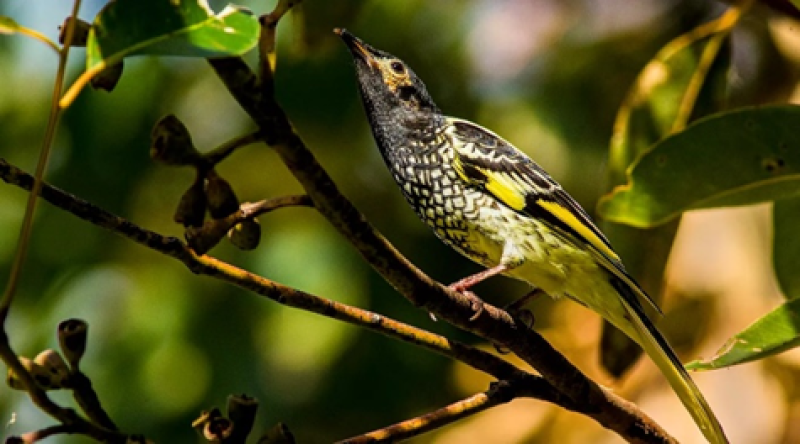Bird of the Month for April 23

Bird of the Month
Regent Bowerbird
Despite their name, not all bowerbirds build bowers. For example, the Tooth-billed Bowerbird merely clears and decorates an area of the forest floor instead of worrying about building a bower. At the other end of the spectrum, the Golden Bowerbird of North Queensland builds an elaborate structure with twin towers of sticks. Most, however, build a bower in the form of an avenue of vertical sticks where the bird can display to attract a mate.
The Regent Bowerbird of eastern Australia is a striking bird with gleaming gold-and-black plumage. It’s so striking, in fact, that it can afford to skimp a little when it comes to building bowers. Unlike most other bowerbirds, which usually fastidiously maintain their bowers for long periods, Regents build light and flimsy structures that are generally short lived. It seems that the more flamboyant the bowerbird, the less elaborate its bower is.
Regent Bowerbirds’ bowers have two parts. First they construct a thick platform of sticks which lie on the ground, and then they insert numerous vertical sticks into the platform, which, after three or four hours, eventually form an avenue, comprising two parallel rows of twigs. The inside of the bower is then decorated with a handful of blue or golden objects, as well as special leaves, seeds and fruits — exactly which items depends on what takes the fancy of individual bowerbirds, and what they can pilfer from their neighbours’ bowers.
It is here that he displays to attract a spotty, brown female, singing to her and presenting her with trinkets.
It seems amazing that with such dazzling plumage, to attract a mate, a male Regent Bowerbird needs to display at a bower at all.
It’s not all glamour, though.
Two eggs are laid in a shallow, scant bowl of course sticks, usually hidden in a tangle of vines or in dense foliage in the tops of trees, where they are incubated by the female for around 20 days. After they hatch, only the female tends to the nestlings.
Regent Bowerbirds mainly eat fruits, taking a wide variety, and because of this, they are sometimes implicated as pests, sneaking into orchards to eat cultivated fruits, and damaging them in the process. It also seems incongruous to see such a beautiful bird scavenging for scraps or insects in backyard compost bins.
If you’d like to know where you can witness the splendid plumage of the Regent Bowerbird, check out BirdLife Australia’s Birdata website.
